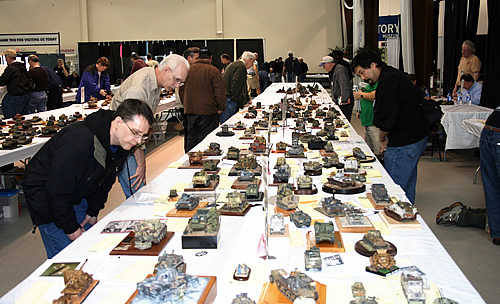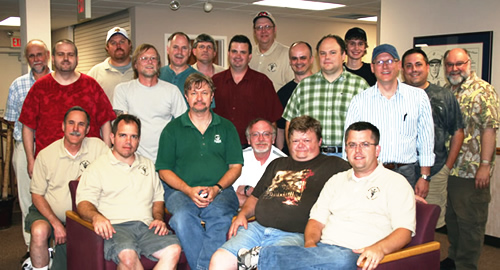|
Band
of Brothers |
 |
|
Modeling tends to be a solitary hobby. We stand in the hobby store aisle or surf the Internet to choose our kits, by plan or impulse, alone. The gluing of bits of plastic is not a group project (though sometimes a third hand would be helpful). We spend hours immersed in research, reading documentation, eyeing photos for details or at least elusive clues. There may be a spouse or significant other who may momentarily look over our shoulder, the inquisitive child whose curious fingers are cause for concern, or the loyal cat or dog who serves as a silent sentinel. But by and large, we work alone. I got back into the hobby in 1990 as an antidote to my professional life in arts management, working as the communications director for a struggling theater company that would soon be put out of its misery by its board of directors. I needed a diversion from my 60-hour work weeks-and for better or worse, the ensuing nine months of unemployment gave me ample time to pursue this new diversion! I needed a hobby where I didn't have to deal with ineffectual committees, ill-conceived projects, and "solutions" were compromises that no one supported. I needed something that was mine, and mine alone, over which I had creative control and I could work on at my own pace. I had long been a writer (a solitary endeavor if there ever was one) and my college training was in playwriting, acting, and directing (satisfying the extroverted "yang" to my writing "yin"). Modeling was
a natural fit for me. I had enjoyed building kits of all types as a kid in the
1960s, but had an affinity for armor and infantry, the old Monogram kits. When
I got back into it in 1990, Tamiya and Italeri kits were brand new to me. Fine
Scale Modeler, Military Model Preview, and the old Military Modeling magazine
were my road maps. I devoured the books Shep Paine and Francois Verlinden to the
point where my eyes had drained the ink from the pages. I had some vague awareness
of a club or two in the Twin Cities from bulletin board postings in the Woodcraft
Hobby and Hub Hobby stores. But I didn't think my skills were at a level worth
exposing, and modeling was geeky enough for a 30-something guy. Why publicly acknowledge
it? As Groucho Marx said, "I wouldn't want to belong to a club that would
have me as a member." As we all know now, the Internet was a boon to modelers. Through the rec.models.scale bulletin board group I had access to experienced modelers and armor historians across the country, like Tom Gannon, Randy Ray, Cookie Sewell, Bob Lessels, and Tom Jentz. Mosaic made it easy to upload and view images—essential for detail-oriented modelers. When Track-Link came online in 1996, we now had a user-friendly site that brought together words, pictures, and easy-to-maneuver discussion forums. With this world wide web of modelers, joining a local club seemed so...yesterday. Like the Little Rascals. Eventually, my skills improved to the point that, in 1999, I decided to "come out" and put my work on the line at a Nordic Con show. I met a number of nice guys who were quite complimentary of my first diorama, Stalingrad Christmas, 1942. I was invited to join a couple clubs. After a few more shows and a few more years, I got off my ass and went to a couple meetings. But the meetings were across town, the times were inconvenient, I was busy with family stuff, etc.
It wasn't until I went to the 2008 AMPS convention in Auburn when I had my epiphany. Being in the midst of so many modelers and so much excellent work really got me jazzed up. I connected with guys that I'd had known only online for years. The seminars were enlightening, and I did a couple turns at the judging table, which gave me a greater appreciation for the philosophy and intent of the AMPS awards system and what to be aware of in my own work. I also had a chance to talk to more with a contingent of local modelers who had made the trek from the Twin Cities (I'd driven on my own since I had a minivan full of my large-sized dioramas). I think what really crystallized in my mind as I drove back was the "AMPS high," the bright joy about the hobby and support of one another's efforts to improve their work. That was the take-away for me. I decided it was time to let down my guard, open my mind and schedule, and formally join the Minnesota Military Figure Society at the very next monthly meeting. A model club is like any other collection of human beings. People join for their own reasons, and they get out of it what they're willing to put into it. Like the stereotypical platoon of soldiers in an old movie, there's a variety of personality types, professions, family backgrounds, socio-economic situations, political viewpoints. Though we have no racial minorities in the club, we do have a teenager. I hope we can increase the numbers of both. Our off-topic discussions get little more contentious than the Vikings-Packers rivalry. We're a pretty mellow bunch. The MMFS has gone through many changes and members since it began in 1973. I'd met a few "characters" at earlier meetings, and they probably put me off some. But they're no longer around, and we have a good group of 25 modelers of varying skills and interests. "Minnesota Nice" in its truest sense prevails, and we bring in our work knowing we'll get constructive suggestions, not belittling criticism. We often have demos where the casual format allows real-time Q&A that enhances understanding of a new technique or subject matter, something you don't necessarily get online. I used to be somewhat intimidated by the "walking encyclopedias" who can rattle off the most arcane data on the most obscure variant of some tank or weapon system, but now I appreciate that these are the guys I'll turn to if I get stumped on something that is in their areas of interest, and they'll be eager to help.
And I try to bring something to the table as well. My interest in minutiae generally extends only to the project that I'm working on or article I'm writing, and evaporates from the brain cells as I move on to the next endeavor. (This is either a process of aging, or the more insidious evolution of a brain that doesn't need to remember because information is now instantly accessible. Anyone who has lost the phone numbers on their cell phone or the data on their hard drive will know what I'm talking about.) So I try to add value to the club through my marketing and organizational skills. This spring, we're having our first show since 1993, and I'm enjoying leading the promotional efforts. Sometimes, doing something for fun is an excellent antidote to doing the same thing for a living! In an ever-alienating and contentious world, it takes extra effort to put one's self out there, to pull away from the safe womb of the work bench and the clickety-clack of the keyboard. Check out your local club and give it a try for a few meetings. Or start a club—it's easier to organize now through the armor and figure website forums. And if you want to be part of the world-wide armor community, consider joining AMPS. As the national convention has untethered itself from Havre de Grace and being held in new locations, it will attract additional modelers, and offer new opportunities to learn and grow. Just
as 3D movies are becoming the rage, now's a good time to remember that models—and
modelers—come in three dimensions as well. |
 |
 |
 |
 |
 |
 |
 |
 |
 |
 |
 |
 |
|

